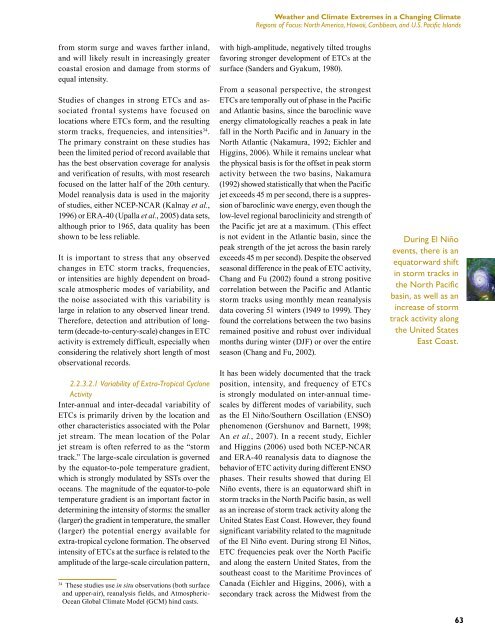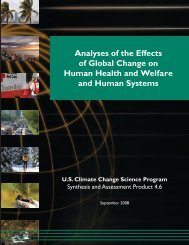Weather and Climate Extremes in a Changing Climate. Regions of ...
Weather and Climate Extremes in a Changing Climate. Regions of ...
Weather and Climate Extremes in a Changing Climate. Regions of ...
You also want an ePaper? Increase the reach of your titles
YUMPU automatically turns print PDFs into web optimized ePapers that Google loves.
from storm surge <strong>and</strong> waves farther <strong>in</strong>l<strong>and</strong>,<br />
<strong>and</strong> will likely result <strong>in</strong> <strong>in</strong>creas<strong>in</strong>gly greater<br />
coastal erosion <strong>and</strong> damage from storms <strong>of</strong><br />
equal <strong>in</strong>tensity.<br />
Studies <strong>of</strong> changes <strong>in</strong> strong ETCs <strong>and</strong> associated<br />
frontal systems have focused on<br />
locations where ETCs form, <strong>and</strong> the result<strong>in</strong>g<br />
storm tracks, frequencies, <strong>and</strong> <strong>in</strong>tensities 34 .<br />
The primary constra<strong>in</strong>t on these studies has<br />
been the limited period <strong>of</strong> record available that<br />
has the best observation coverage for analysis<br />
<strong>and</strong> verification <strong>of</strong> results, with most research<br />
focused on the latter half <strong>of</strong> the 20th century.<br />
Model reanalysis data is used <strong>in</strong> the majority<br />
<strong>of</strong> studies, either NCEP-NCAR (Kalnay et al.,<br />
1996) or ERA-40 (Upalla et al., 2005) data sets,<br />
although prior to 1965, data quality has been<br />
shown to be less reliable.<br />
It is important to stress that any observed<br />
changes <strong>in</strong> ETC storm tracks, frequencies,<br />
or <strong>in</strong>tensities are highly dependent on broadscale<br />
atmospheric modes <strong>of</strong> variability, <strong>and</strong><br />
the noise associated with this variability is<br />
large <strong>in</strong> relation to any observed l<strong>in</strong>ear trend.<br />
Therefore, detection <strong>and</strong> attribution <strong>of</strong> longterm<br />
(decade-to-century-scale) changes <strong>in</strong> ETC<br />
activity is extremely difficult, especially when<br />
consider<strong>in</strong>g the relatively short length <strong>of</strong> most<br />
observational records.<br />
2.2.3.2.1 Variability <strong>of</strong> Extra-Tropical Cyclone<br />
Activity<br />
Inter-annual <strong>and</strong> <strong>in</strong>ter-decadal variability <strong>of</strong><br />
ETCs is primarily driven by the location <strong>and</strong><br />
other characteristics associated with the Polar<br />
jet stream. The mean location <strong>of</strong> the Polar<br />
jet stream is <strong>of</strong>ten referred to as the “storm<br />
track.” The large-scale circulation is governed<br />
by the equator-to-pole temperature gradient,<br />
which is strongly modulated by SSTs over the<br />
oceans. The magnitude <strong>of</strong> the equator-to-pole<br />
temperature gradient is an important factor <strong>in</strong><br />
determ<strong>in</strong><strong>in</strong>g the <strong>in</strong>tensity <strong>of</strong> storms: the smaller<br />
(larger) the gradient <strong>in</strong> temperature, the smaller<br />
(larger) the potential energy available for<br />
extra-tropical cyclone formation. The observed<br />
<strong>in</strong>tensity <strong>of</strong> ETCs at the surface is related to the<br />
amplitude <strong>of</strong> the large-scale circulation pattern,<br />
34 These studies use <strong>in</strong> situ observations (both surface<br />
<strong>and</strong> upper-air), reanalysis fields, <strong>and</strong> Atmospheric-<br />
Ocean Global <strong>Climate</strong> Model (GCM) h<strong>in</strong>d casts.<br />
<strong>Weather</strong> <strong>and</strong> <strong>Climate</strong> <strong>Extremes</strong> <strong>in</strong> a Chang<strong>in</strong>g <strong>Climate</strong><br />
<strong>Regions</strong> <strong>of</strong> Focus: North America, Hawaii, Caribbean, <strong>and</strong> U.S. Pacific Isl<strong>and</strong>s<br />
with high-amplitude, negatively tilted troughs<br />
favor<strong>in</strong>g stronger development <strong>of</strong> ETCs at the<br />
surface (S<strong>and</strong>ers <strong>and</strong> Gyakum, 1980).<br />
From a seasonal perspective, the strongest<br />
ETCs are temporally out <strong>of</strong> phase <strong>in</strong> the Pacific<br />
<strong>and</strong> Atlantic bas<strong>in</strong>s, s<strong>in</strong>ce the barocl<strong>in</strong>ic wave<br />
energy climatologically reaches a peak <strong>in</strong> late<br />
fall <strong>in</strong> the North Pacific <strong>and</strong> <strong>in</strong> January <strong>in</strong> the<br />
North Atlantic (Nakamura, 1992; Eichler <strong>and</strong><br />
Higg<strong>in</strong>s, 2006). While it rema<strong>in</strong>s unclear what<br />
the physical basis is for the <strong>of</strong>fset <strong>in</strong> peak storm<br />
activity between the two bas<strong>in</strong>s, Nakamura<br />
(1992) showed statistically that when the Pacific<br />
jet exceeds 45 m per second, there is a suppression<br />
<strong>of</strong> barocl<strong>in</strong>ic wave energy, even though the<br />
low-level regional barocl<strong>in</strong>icity <strong>and</strong> strength <strong>of</strong><br />
the Pacific jet are at a maximum. (This effect<br />
is not evident <strong>in</strong> the Atlantic bas<strong>in</strong>, s<strong>in</strong>ce the<br />
peak strength <strong>of</strong> the jet across the bas<strong>in</strong> rarely<br />
exceeds 45 m per second). Despite the observed<br />
seasonal difference <strong>in</strong> the peak <strong>of</strong> ETC activity,<br />
Chang <strong>and</strong> Fu (2002) found a strong positive<br />
correlation between the Pacific <strong>and</strong> Atlantic<br />
storm tracks us<strong>in</strong>g monthly mean reanalysis<br />
data cover<strong>in</strong>g 51 w<strong>in</strong>ters (1949 to 1999). They<br />
found the correlations between the two bas<strong>in</strong>s<br />
rema<strong>in</strong>ed positive <strong>and</strong> robust over <strong>in</strong>dividual<br />
months dur<strong>in</strong>g w<strong>in</strong>ter (DJF) or over the entire<br />
season (Chang <strong>and</strong> Fu, 2002).<br />
It has been widely documented that the track<br />
position, <strong>in</strong>tensity, <strong>and</strong> frequency <strong>of</strong> ETCs<br />
is strongly modulated on <strong>in</strong>ter-annual timescales<br />
by different modes <strong>of</strong> variability, such<br />
as the El Niño/Southern Oscillation (ENSO)<br />
phenomenon (Gershunov <strong>and</strong> Barnett, 1998;<br />
An et al., 2007). In a recent study, Eichler<br />
<strong>and</strong> Higg<strong>in</strong>s (2006) used both NCEP-NCAR<br />
<strong>and</strong> ERA-40 reanalysis data to diagnose the<br />
behavior <strong>of</strong> ETC activity dur<strong>in</strong>g different ENSO<br />
phases. Their results showed that dur<strong>in</strong>g El<br />
Niño events, there is an equatorward shift <strong>in</strong><br />
storm tracks <strong>in</strong> the North Pacific bas<strong>in</strong>, as well<br />
as an <strong>in</strong>crease <strong>of</strong> storm track activity along the<br />
United States East Coast. However, they found<br />
significant variability related to the magnitude<br />
<strong>of</strong> the El Niño event. Dur<strong>in</strong>g strong El Niños,<br />
ETC frequencies peak over the North Pacific<br />
<strong>and</strong> along the eastern United States, from the<br />
southeast coast to the Maritime Prov<strong>in</strong>ces <strong>of</strong><br />
Canada (Eichler <strong>and</strong> Higg<strong>in</strong>s, 2006), with a<br />
secondary track across the Midwest from the<br />
Dur<strong>in</strong>g El Niño<br />
events, there is an<br />
equatorward shift<br />
<strong>in</strong> storm tracks <strong>in</strong><br />
the North Pacific<br />
bas<strong>in</strong>, as well as an<br />
<strong>in</strong>crease <strong>of</strong> storm<br />
track activity along<br />
the United States<br />
East Coast.<br />
63




